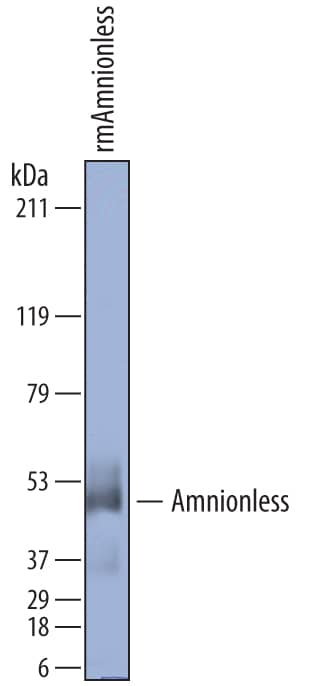Mouse Amnionless Antibody
R&D Systems, part of Bio-Techne | Catalog # AF7139

Key Product Details
Species Reactivity
Applications
Label
Antibody Source
Product Specifications
Immunogen
Ala20-Gly362
Accession # Q99JB7
Specificity
Clonality
Host
Isotype
Scientific Data Images for Mouse Amnionless Antibody
Detection of Mouse Amnionless by Western Blot.
Western blot shows recombinant mouse Amnionless (10 ng/lane). PVDF membrane was probed with 1 µg/mL of Sheep Anti-Mouse Amnionless Antigen Affinity-purified Polyclonal Antibody (Catalog # AF7139) followed by HRP-conjugated Anti-Sheep IgG Secondary Antibody (Catalog # HAF016). A specific band was detected for Amnionless at approximately 49 kDa (as indicated). This experiment was conducted under reducing conditions and using Immunoblot Buffer Group 8.Amnionless in Mouse Kidney.
Amnionless was detected in perfusion fixed frozen sections of mouse kidney using Sheep Anti-Mouse Amnionless Antigen Affinity-purified Polyclonal Antibody (Catalog # AF7139) at 15 µg/mL overnight at 4 °C. Tissue was stained using the NorthernLights™ 557-conjugated Anti-Sheep IgG Secondary Antibody (red; Catalog # NL010) and counterstained with DAPI (blue). Specific staining was localized to convoluted tubules. View our protocol for Fluorescent IHC Staining of Frozen Tissue Sections.Applications for Mouse Amnionless Antibody
Immunohistochemistry
Sample: Perfusion fixed frozen sections of mouse kidney
Western Blot
Sample: Recombinant Mouse Amnionless
Formulation, Preparation, and Storage
Purification
Reconstitution
Formulation
Shipping
Stability & Storage
- 12 months from date of receipt, -20 to -70 °C as supplied.
- 1 month, 2 to 8 °C under sterile conditions after reconstitution.
- 6 months, -20 to -70 °C under sterile conditions after reconstitution.
Background: Amnionless
AMN (Amnionless) is a 45-49 kDa glycoprotein that is expressed by three cell types in mouse; extraembryonic visceral endoderm, proximal tubule renal epithelium, and absorption intestinal epithelium. AMN is required for gastrulation in rodent (but not human), and participates in Vitamin B12 absorption in the gut. In particular, AMN forms a membrane complex with Cubilin, promoting its proper orientation in the membrane and subsequent binding to the Intrinsic factor: VitB12 complex. Mature mouse AMN is a 439 amino acid (aa) type I transmembrane protein. It contains a 343 aa extracellular region (aa 20-362) that possesses one VWFC domain (aa 203‑254), and a 75 aa cytoplasmic tail. In human, AMN may undergo cleavage to generate a 35 kDa soluble fragment. Over aa 20-362, mouse AMN shares 92% and 67% aa sequence identity with rat and human AMN, respectively.
Additional Amnionless Products
Product Documents for Mouse Amnionless Antibody
Product Specific Notices for Mouse Amnionless Antibody
For research use only

